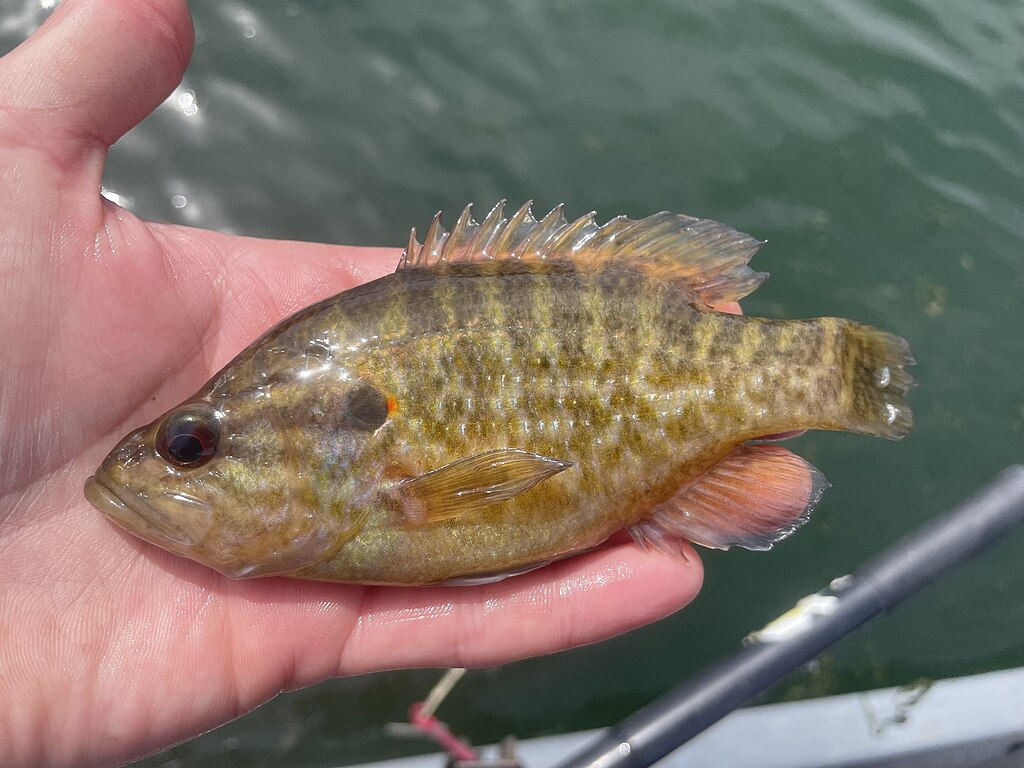
Warmouth
Scientific Name: Lepomis gulosus
Also known as: Red-throat Sunfish, Warmouth Bass, Goggle-eye, Stumpknocker
General Description
The Warmouth is a relatively small, colorful member of the sunfish family, closely related to the bluegill and longear sunfish. With a body that can reach up to 10 inches, the Warmouth has a broad, compressed shape with a large mouth that distinguishes it from other sunfish species. The Warmouth’s coloration ranges from olive to dark brown, with a lighter belly and vertical bars running down its sides. The most noticeable feature is its dark, large eye and the reddish hue around its throat, particularly in males during the breeding season.
Known for its aggressive feeding habits, the Warmouth can often be found hiding in cover such as submerged structures, under rocks, and in weedy areas where it preys on small fish, invertebrates, and aquatic insects. This species is often sought after by anglers for its strong fight relative to its size and the thrill it provides when hooked. Despite its smaller stature compared to other species like largemouth bass or catfish, the Warmouth’s willingness to bite and its tenacity makes it an exciting catch for anglers.
Though it doesn’t grow as large as some sunfish species, the Warmouth can still provide a satisfying challenge and an enjoyable fishing experience, especially for those fishing in warm, shallow waters.
Where to Find Them
Warmouth are typically found in slow-moving, shallow waters such as ponds, lakes, and sluggish rivers. They prefer areas with plenty of cover, such as submerged logs, brush piles, rocks, and aquatic vegetation. These fish tend to inhabit weedy flats, the edges of aquatic plants, and areas near deep drop-offs, where they can hide from predators and ambush their prey. Warmouth are often located near the shoreline, especially in the warmer months, and they prefer to stay in relatively warm waters, typically ranging between 60 to 85 degrees Fahrenheit.
The species is most commonly found in the southeastern United States, particularly in states such as Florida, Texas, Alabama, and Louisiana. They are native to these areas but have been introduced in various other regions throughout North America. Warmouth are adaptable to a variety of habitats and can be found in both standing and slow-moving water, making them a versatile species for anglers to target.
While Warmouth prefer warmer water temperatures, they can be found year-round, with fishing activity peaking in spring and summer when they are most active. During the spawning season, typically in late spring to early summer, Warmouth move into shallower waters and become more accessible to anglers. This makes the early summer months particularly ideal for targeting them, as they are more concentrated in these areas.
Best Baits
Live Bait Options
- Nightcrawlers
- Minnows
- Crickets
- Small shad
- Worms
Artificial Bait Options
- Small crankbaits (natural colors like brown, green, or silver)
- Soft plastic worms
- Tiny jigs (1/16 oz)
- Tube baits
- Spinners
Best Fishing Methods
Fishing for Warmouth often involves using bottom fishing techniques, as this species tends to stay close to the bottom in areas where they can find shelter. Carolina rigs are an excellent option for anglers using live bait, as they allow the bait to stay on the bottom, enticing the Warmouth to bite. Jigging with small soft plastics or live worms is another effective technique, as it mimics the movement of insects and small fish that Warmouth prey upon.
When using artificial lures, small crankbaits and tube baits are great options, especially in natural colors that resemble minnows or small sunfish. Spinnerbaits can also be productive, especially when fishing in areas with low visibility, as the flash from the spinner attracts the Warmouth. In clear water, small jigs in earthy tones like brown or green can be very effective. These lures should be worked slowly along the bottom to ensure the Warmouth detects the bait.
Since Warmouth are often found in weedy areas or near submerged structures, fishing near these types of cover is key. Anglers should focus on casting near rocks, fallen trees, or vegetation to entice these fish to bite. Drifting along the shallows or slowly retrieving lures through cover are great ways to increase your chances of success. Warmouth can be aggressive, so once you find them, you may catch several in the same area.
Summary
Fishing for Warmouth offers an exciting challenge, particularly for anglers looking for a smaller yet aggressive fish. This species is found primarily in the southeastern United States in shallow, slow-moving waters with abundant cover. Warmouth are aggressive feeders, striking at both live and artificial baits, making them an ideal target for anglers who enjoy using a variety of techniques.
To catch Warmouth, anglers often use bottom fishing techniques, jigging, and drifting near cover such as submerged rocks, logs, or aquatic vegetation. Live baits like worms, crickets, and minnows are effective, while artificial lures like small crankbaits, jigs, and tube baits can also yield great results. Since Warmouth are most active during warmer months, spring and summer are the best times to target them. They are often found in the shallows during their spawning season, making it easier for anglers to locate and catch them.
While they may not grow as large as other sunfish species, Warmouth still provide an exciting fight and are a great option for anglers looking to enjoy a rewarding fishing experience. Their willingness to bite and their strong, aggressive nature make them a fun and challenging fish to pursue, especially for anglers fishing in warmer, shallow waters.


